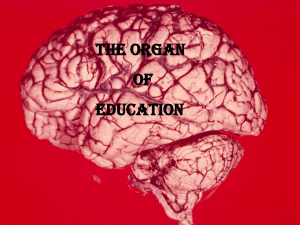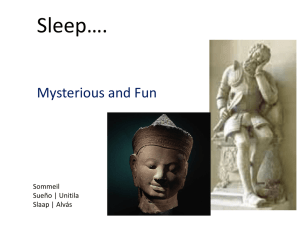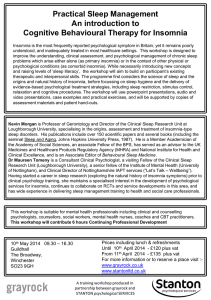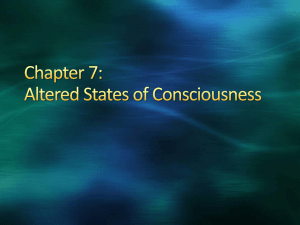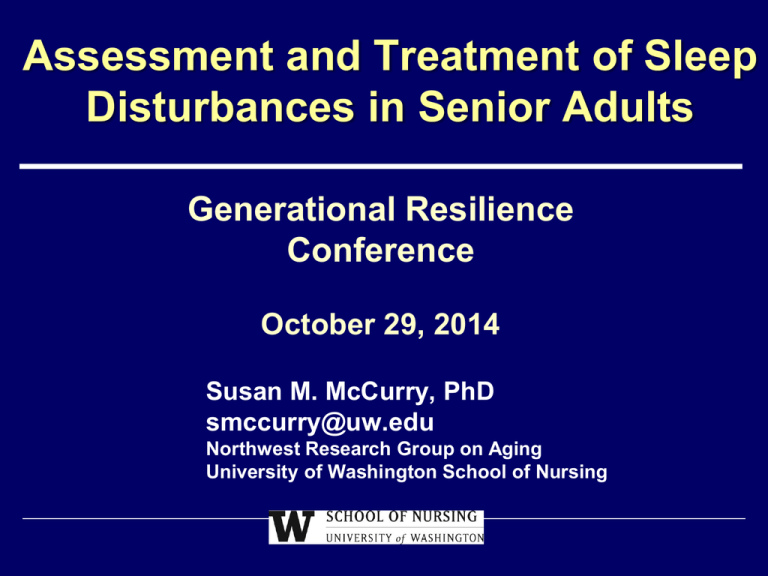
Assessment and Treatment of Sleep
Disturbances in Senior Adults
Generational Resilience
Conference
October 29, 2014
Susan M. McCurry, PhD
smccurry@uw.edu
Northwest Research Group on Aging
University of Washington School of Nursing
Agenda for Today’s Talk
What is sleep?
What causes sleep disturbances as we
age?
How do you measure sleep disruption
and quality?
What are your treatment options?
Why are non-pharmacological treatments
not more widely used?
Sleeping is no mean art: for its sake
one must stay awake all day.
~Friedrich Nietzsche
What is Sleep Anyway????
STAGE 1
Transition to Sleep
REM Sleep
Dreaming
Body paralysis
Increased HR,
BP, temp
Easily awakened
Muscle twitching
STAGE 2
Light Sleep
Heart rate, eye
movements slow
down
Delta wave sleep
STAGE 4
Deepest Sleep
STAGE 3
Deep Sleep
BP, body temp
decrease
Rhythmic breathing
Slow brainwaves
Hard to wake
Restorative
Hypnogram: Young vs. Old
Sleep Stages
Awake
REM
1
2
3
Young Adult
4
1
2
3
4
5
6
7
6
7
Sleep Stages
Awake
REM
1
2
3
Older Adult
4
1
Courtesy of Carol Landis, PhD
2
3
4
Hours of Sleep
5
1. Homeostatic Process
Sleep need (“drive”)
increases the longer you
are awake.
sleepy
What Regulates Sleep?
Awake
sleepy
2. The Circadian Process
(Biological Clock)
The propensity to sleep
varies as a function of the
time of day/night over 24
hours.
Sleep
Awake
Sleep
Germain A, Buysse DJ. Brief behavioral treatment of insomnia. In: Perlis M, et al. (eds.). Behavioral
treatments for sleep disorders, pp. 143-150. Elsevier, 2011.
Homeostatic and Circadian Sleep
Processes Work Together
“Drive”
Edgar DM, Dement WC, Fuller CA, et al. Effect of SCN lesions on sleep in squirrel monkeys: evidence
for opponent process in sleep-wake regulation. J Neurosci. 1993;13:1065-1079.
Circadian Rhythm Changes: Advanced
Sleep Phase
Sleepy,
Go to bed
Normal
Phase
Wake
Up
1600 1800 2000 2200 2400 0200 0400 0600 0800 1000
Advanced
Phase
Sleepy
Go to bed
Wake up
Ancoli-Israel, S. 1996. All I want is a good night’s sleep. Mosby.
Points to Remember #1
Older adults do not need less sleep
than younger adults
BUT
Aging reduces ability to achieve
desired quantity and quality of
sleep
Sleep Disturbance Risk Factors
• Age-related change in sleep mechanisms
• Dementia
Least
Modifiable
• Primary sleep disorders
• Other co-morbid conditions and treatments
• Environmental and behavioral factors
• Any combination of the above
Bloom et al. J Am Geriatr Soc. 2009; 57(5): 761-789; McCurry et al. Sleep Med Rev . 2000; 4:603-608.
Most
Modifiable
Sleep and Dementia
Alzheimer’s disease
•
Loss of neurons that regulate circadian sleep-wake
cycles (SCN: the body’s internal “clock”) and
thermoregulatory processes
•
Sleep architecture changes resemble an
acceleration of normal age-related changes
Parkinson’s disease and related disorders
• Sleep problems nearly universal in advanced PD
• Tremors, muscle contractions and cramps, limb
jerks, nocturia, nightmares, daytime “sleep attacks”
Primary Sleep Disorders
Obstructive sleep apnea (OSA)
• Overlapping risk factors for stroke (HTN, diabetes, atrial
fibrillation, cardiac and carotid disease)
• Widely underdiagnosed; compliance w/CPAP often poor
Periodic leg movement syndrome (PLMS)
Restless legs syndrome
• Linked to low iron levels
• In persons with dementia more strongly associated with
nocturnal agitation than OSA and PLMS
REM sleep behavior disorder (RBD)
• Most common in older men
• Increased in persons with
Parkinson’s
Philips B, et al. 2000. Arch Intern Med, 160: 2137-2141
Gehrman PR, et al. 2003. J Am Geriatr Psychiatry, 11: 426-433
Young T, et al. 2004. JAMA, 291:2013-2016.
Rose KM, et al. 2011. Sleep, 34:779-786
Laugh and the world laughs with
you, snore and you sleep alone.
Anthony Burgess
Insomnia and Medical / Psychiatric
Conditions (National Health Interview Survey)
50
Comorbidity Frequency, %
45.9
No Insomnia
Insomnia
45
40
35
30.3
29.4
30
25
20
20.9
16.6
15
10.8
9.3
10
5.6
5
0.7
3.0
0
Hypertension
CHF
Diabetes
Obesity
Pearson NJ, Johnson LL Nahin RL.. Arch Intern Med 2006 166: 1775-1782
Anxiety or
Depression
Drugs that Can Worsen Sleep
•
Alcohol
•
CNS stimulants (e.g., caffeine, theophylline,
nicotine)
•
Beta-blockers, calcium channel blockers
•
Bronchodilators
•
Corticosteroids
•
Decongestants
•
Diuretics
•
Stimulating antidepressants, cognitive enhancers
•
Thyroid hormones
Environmental & Behavioral Causes
•
•
•
•
•
•
•
•
•
•
Noise
Light
Temperature
Season of year
Bedding
Television
Dietary practices
Exercise routines
Pets
Roommate or bed partner behaviors
There is no snooze button on a
cat who wants breakfast.
~Author Unknown
Points to Remember #2
Many physical and environmental
risk factors for sleep problems are
common in older adults and should
be considered as part of any sleep
assessment and plan.
What is Insomnia?
Diagnostic Criteria (DSM-5)
Dissatisfaction with sleep quality or duration
Subjective difficulties initiating/maintaining
sleep (generally lasting 30+ minutes/night)
Insomnia (or daytime fatigue) causes
marked distress or significant impairment in
social or occupational functioning
Sleep difficulties are present 3 nights or
more per week and for more than 3 months
Despite adequate opportunity to sleep
Prevalence of insomnia
Insomnia Symptoms
with Daytime Impairments
33%
10%
Sleep Dissatisfaction
15%
Insomnia Diagnosis
6-12%
Ohayon MM. Sleep Med Rev 2002; 6:97-111; Morin et al. Sleep Med 2006; 7:123-130
Insomnia Assessment: History
1. The healthcare practitioner should screen patients
for symptoms of insomnia during health
examinations.
2. An in-depth sleep history is essential in identifying
the cause of insomnia.
3. Polysomnography is not indicated for the routine
evaluation of chronic insomnia.
Standard.
AASM Practice Parameters for the Evaluation of
Chronic Insomnia
Chesson A. et al. Sleep. 2000; 23(2): 1-5.
Edinger JD et al. Sleep 2004; 27(8):1567-96 (Research Diagnostic Criteria for Insomnia)
Insomnia History
Daytime activities and impairments: Napping,
fatigue, cognitive function, mood
Sleep related practices and environment
(“sleep hygiene”)
Longitudinal course
General medical history (including diagnoses of
primary sleep disorders)
Psychiatric history
Medication and substance use
Life situation and circumstances (stressors)
Self-Administered Questionnaires
Assessment Domain
Instrument
Global sleep
Pittsburgh Sleep Quality Index (PSQI)
Insomnia symptoms
Insomnia Severity Index (ISI)
Fatigue
Flinders Fatigue Scale (FFS)
Sleepiness
Epworth Sleepiness Scale (ESS)
Attitudes about sleep
Dysfunctional Beliefs About Sleep (DBAS)
scale
Sleep-related behaviors
Sleep Hygiene Index (SHI)
Quality of life
SF-36 (includes pain subscale)
Psychological symptoms
Patient Health Questionnaire (PHQ-9)
Generalized Anxiety Disorder scale (GAD-8)
Pre-Sleep Arousal Scale (PSAS)
Undiagnosed primary
sleep disorders
Berlin Apnea Questionnaire
Restless legs single question*
*When you try to relax in the evening or sleep at night, do you ever have unpleasant, restless
feelings in your legs that can be relieved by walking or movement? (Ferri R. et al. 2007)
Purpose of Questionnaires
Capture subjective aspects of sleep experience
that may not be reflected in objective measures
Generally quick to administer
Many have good validity/reliability data and
shown to be sensitive to change in RTCs
Many validated with senior populations
Can use multiple measures to assess the
heterogeneous context of insomnia symptoms
Limitations to Questionnaires
No consistency in referent time frame (generally
1 week to 1 month)
Subjects often fill out incorrectly (e.g., leave
items blank, circle 2 options, write explanatory
notes in the margins)
Poor readers, non-native English speakers may
have difficulty with them
Few are validated for use with other cultures
Can be expensive to use proprietary instruments
Purpose of Daily Sleep Diaries
Teach people to observe their own sleep
habits and patterns
Gather daily sleep quality/satisfaction data
over time
Can collect other real-time data related to
sleep (e.g., daily pain or depression
ratings)
Provide validation check for actigraphy
data editing
Graphic sleep diary in insomnia patient
DJ Buysse. Advanced Practice in Primary and Acute Care Conference, November 10, 2007,
Seattle, WA
Limitations to Daily Diaries
Wide variability in diaries across users
(c.f., Carney
et al. Sleep 2012; 35(2): 287-302)
Some people don’t like to keep them,
especially for weeks at a time
They are often filled out incorrectly
If not completed every day poor recall can
invalidate data
Computing daily sleep stats for clinical review
can be cumbersome
Tricks for Getting Good Diary Data
Provide clear written instructions and repeated
practice in how to complete
Review diaries every week when they are
returned and follow up immediately when there
are problems
Particularly look for patterns suggestive of backfilling
Keep diary as brief and as simple as possible
If using paper diaries, put all weeks into a single
booklet
Purpose of Actigraphy/Acclerometers
Provide objective measure of sleep/wake
(activity) across the 24 hour period
Data can be collected for longer period of
time and at less cost/personnel training than
PSG
Some provide additional sensory measures
(e.g., light or sound readings)
Some insurance companies are covering
Actigraphic Sleep Assessment
Normal Sleeper
Person with dementia
Wake/activity
Sleep/inactivity
Time of day
Problems with Actigraphy
Although cheaper than PSG, actigraphs plus
software are not inexpensive
Wide variability in types of equipment, scoring
algorithms, and editing procedures across studies
Some people don’t like to wear them
Data failure is not rare
Analysis can be complicated and time-consuming
(Note: Although easy to use, devices like Fitbit
are not comparable to actigraphic scoring)
Tricks for Getting Good Actigraphy Data
Careful training and QA monitoring of
persons who do initialization, downloading,
and editing
Hospital bands for at-risk patients can
facilitate compliance keeping the device on
Don’t count on devices being fully
waterproof
Make friends with your company tech
support staff
Points to Remember #3
Assessment of insomnia should include a
combination of sleep history and
standardized self-report questionnaires.
Sleep diaries and actigraphy provide
additional information on day-to-day
variability and sleep patterns.
All have been validated with older adults.
How Is Insomnia Treated???
Treatment Strategies
Treatment for
insomnia
Pharmacologic
CognitiveBehavioral
(CBT-I)
Pharmacological Approaches
Hypnotics – Benzodiazepines
Hypnotics – Benzodiazepines Receptor Agonists (BZRAs)
•
•
•
Melatonin agonists
•
Ramelteon (Rozerem*)
Antidepressants
•
Zaleplon (Sonata)
Zolpidem (Ambien, Ambien-CR*)
Eszopiclone (Lunesta*)
Doxepin (Silenor*)
Others agents currently available or in development:
•
•
•
OTC - Melatonin, valerian, anti-histamines, etc.
Prescription - Anti-depressants (e.g.,trazodone), antipsychotics, HTN meds (prazosin; PTSD nightmares)
In development –5HT, GABA and Hypocretin/Orexin
Sedating Medications and Aging
Don’t always help or they stop working
Can cause unwanted side effects (poor
balance, confusion, paradoxical reactions)
Primarily tested in younger adults with different
pharmacokinetics
Polypharmacy is always a concern
Not preferred by many older adults
Few randomized efficacy trials with specialty
populations, e.g., persons with dementia
Advantages of CBT for Insomnia
Addresses perpetuating and, in some cases,
precipitating causes of sleep disturbances
No interactions with other medications or side
effects
Can improve symptoms of comorbid conditions
Can reduce need for long-term hypnotic
medications (or help taper off)
Empowering for patients; provides tools they
can use in future situations
The 3-P Model of Insomnia
• How did your insomnia start?
• Predisposing factors (genetics, biological traits,
personality, “owls” and “larks”)
• Precipitating factors (“triggers,” e.g., illness, pain,
bereavement, work stressors, shift changes)
• Why is it still here?
• Perpetuating factors that undermine underlying
homeostatic (sleep drive) or circadian processes
(e.g., staying in bed longer, going to bed early, napping,
practicing counter-fatigue [e.g., caffeine] or selfmedication [e.g., ETOH, OTC sleep aid] strategies)
Spielman’s Modified 3-P Model
Insomnia
Insomnia
Threshold
No Insomnia
Preclinical
Acute Onset
Predisposing
Early Insomnia Chronic Insomnia
Precipitating
Perpetuating
Kryger MH, et al. Principles and Practice of Sleep Medicine. 4th ed. New York, NY: Saunders; 2000;
Perlis et al Cognitive Behavioral Treatment of Insomnia. New York, NY: Springer; 2005
CBT-I Multicomponent Approach
Domain
Technique
Aim
Sleep hygiene
Promote habits and
environments that help sleep
Strengthen bed and bedroom
Stimulus control
Behavioral
as sleep stimuli
components
Sleep (bed) restriction Restrict time in bed to improve
sleep depth and consolidation
Cognitive therapy
Address thoughts and beliefs
that interfere with sleep
Cognitive
Relaxation training
components
Acceptance based
Reduce arousal and decrease
anxiety
Circadian
Circadian rhythm
components entrainment
Reset or reinforce biological
rhythm
Decrease struggle to control
sleep at cost of living your life
Cognitive-Behavioral Treatment for
Insomnia Multicomponent Approach
Domain
Technique
Aim
Sleep hygiene
Promote habits and
environments that help sleep
Strengthen bed and bedroom
Stimulus control
Behavioral
as sleep stimuli
components
Sleep (bed) restriction Restrict time in bed to improve
sleep depth and consolidation
Sleep Hygiene Recommendations
•
Regularize sleep / wake schedules (especially rise time)
•
Establish a relaxing bedtime routine
•
Increase daytime light exposure, keep sleep areas dark
•
Reduce alcohol and caffeine use
•
Keep bedroom a comfortable (cooler) temperature
•
Eliminate environmental factors that interrupt sleep (pets!)
•
Avoid stimulants and stimulating behavior at night
(including screens and radio if you wake up during at night)
•
Don’t watch the clock if you can’t sleep (turn it around!)
•
Get regular exercise
•
Ask your pharmacist about medication side effects
Stepanski EJ, Whatt JK. 2002 Sleep Med Rev, 7(3)::215-225
Sleep Hygiene: Contraindications
• Non-compliance
• “There is nothing more uncommon than
common sense.” ~Frank Lloyd Wright
• People so rarely follow suggestions on lists like
this that sleep hygiene recommendations are
often used as a control condition in
randomized trials
• When they do try to make changes, they often
don’t stick with them
Stimulus Control
To prevent your bedroom from becoming
associated with poor night sleep, do the
following:
• Get up at the same time every day, no
matter how much you slept the night before
• Don’t go to bed if you are not sleepy
• Get out of bed if you wake up and can’t
back to sleep right away (~15 mins) rather
than stay in bed fretting about being awake
fall
• Do not nap during the day (except brief “power naps”)
• Use bed only for sleep and sex
If you can't sleep, then get up
and do something instead of
lying there worrying. It's the
worry that gets you, not the lack
of sleep.
~Dale Carnegie
Stimulus Control: Contraindications
• Stimulus control is contraindicated in
those:
• Persons who are disabled and cannot easily get out
of bed unassisted
• People at risk for slips and falls
• Persons without cognitive capacity to follow stimulus
control instructions
• People who develop a habit of getting up in the
middle of night to “do things”
Bootzin RR & Perlis ML. Stimulus control therapy. In: Perlis M, et al. (eds.). Behavioral treatments for sleep
disorders, pp. 21-30. Elsevier, 2011.
Bed Restriction
• If you reduce your time in bed, you
increase your time awake
• Being awake longer will help you fall asleep faster
and stay asleep for more of the night
• How long should I stay in bed?
• Keep a sleep diary for 5 – 7 days
• Write down time you went to bed, time you got up,
and estimate how much of that time you were asleep
• Bed restriction time = estimated week sleep time
average plus 30 minutes
Bed Restriction Example
• 7 day sleep log
• How long should I stay in
bed?
Went to
Bed
Got up
I was
awake
about
this
much
So I got
about
this
much
sleep
•
Write down time you went to bed,
time you got up, and estimate how
much of that time you were asleep
•
Bed restriction time = estimated
weekly sleep time average
11:15 pm 8:45 am 3 hr
6.5 hr
10:20 pm 8:20 am 3 hr
7 hr
So in this example, you would
restrict yourself to 7 hours in bed
per night for one week (reduced
from 9 hours)
10:30 pm 8:00 am 3 hr
6.5 hr
10:30 pm 8:15 am 45 mins
9 hr
11:00 pm 7:30 am 1 hr
7.5 hr
11:30 pm 8:30 am 2.5 hr
6/5 hr
12:15 am 7:45 am 2 hr
5.5 hr
11:03 pm 8:09 am
6.9 hrs
•
•
•
Pick your target rising time and
work backwards to set bed time
Monitor with daily log
Averages:
2.2 hrs
Modifying Bed Restriction Plans
If after one week you are
• Falling asleep at night in less than 30 minutes
AND
• Spending less than 30 minutes awake during the night
OR
• Sleep percent (TST/TIB) > 85% (=“sleep efficiency”)
THEN increase your time in bed “sleep window” 15
minutes
If you are still having trouble sleeping
Stick with the plan another week
OR
Cut back your time in bed by going to bed 15 minutes later
Bed Restriction: Contraindications
• Bed restriction is contraindicated in those:
• Conditions that are exacerbated by sleepiness
(epilepsy, mania, parasomnias [e.g., sleep walking],
sleep disordered breathing)
• People who need to maintain vigilance, e.g., longhaul truck drivers, air traffic controllers, etc.
• Short sleep latencies and regular compact sleep
times
• Some people will refuse to follow restricted schedule
Spielman AJ, et al. Sleep restriction therapy. In: Perlis M, et al. (eds.). Behavioral treatments for sleep
disorders, pp. 9-20. Elsevier, 2011.
Sleep Compression: A Kinder,
Gentler Way….
• 7 day sleep log
• How long should I stay in
Went to
Bed
Got up
bed?
•
TIB this week = ~9 hours/night
•
Target TIB = ~7 hours/night
•
I was
awake
about
this
much
So I got
about
this
much
sleep
11:15 pm 8:45 am 3 hr
6.5 hr
10:20 pm 8:20 am 3 hr
7 hr
Subtract target from current
TIB (9 – 7 = 2 hours)
10:30 pm 8:00 am 3 hr
6.5 hr
•
Divide difference by 4 (2 hours
/ 4 = 30 minutes)
10:30 pm 8:15 am 45 mins
9 hr
11:00 pm 7:30 am 1 hr
7.5 hr
•
Set rise time then reduce TIB
30 minutes each week
11:30 pm 8:30 am 2.5 hr
6/5 hr
12:15 am 7:45 am 2 hr
5.5 hr
11:03 pm 8:09 am
6.9 hrs
− Week 1: 10:30-7:00
− Week 2: 11:00-7:00
− Week 3: 11:30-7:00
− Week 4: 11:30-6:30
Averages:
2.2 hrs
General Disadvantages to Behavioral
Strategies
• Meds are widely available and work rapidly
(when effective)
• Non-compliance and attrition are common
due to effort and discomfort
• Things may get worse before they get better
(improvements may not be seen until 3-4
weeks)
• Require closer diary monitoring than meds
Cognitive-Behavioral Treatment for
Insomnia Multicomponent Approach
Domain
Technique
Aim
Cognitive therapy
Address thoughts and beliefs
that interfere with sleep
Cognitive
Relaxation training
components
Acceptance based
Reduce arousal and decrease
anxiety
Decrease struggle to control
sleep at cost of living your life
Attention-Intention Effort (AIE)
Pathway
Normal and automatic sleep processes become
disrupted when individuals selectively focus on:
Attention to
sleep
Intention
to sleep
Effort to
sleep
In other words, worrying about sleep makes it
harder to sleep
Espie, C.A., et al. Sleep Medicine Reviews, 10:215-245, 2006.
Insomnia and Cognitive Effort
• People with insomnia …
•
Tend to use more thought control strategies
(suppression, reappraisal, worry)
•
Are more involved in
excessive and counterproductive thinking about
sleep and daytime function
•
Have more hyper-arousal
and anxiety
Cognitive Therapy
• Address misconceptions about sleep
• I must get 8 hours/sleep at night to function
• I can control how much I sleep
• All daytime problems are due to my lack of sleep
• Cognitive arousal (“Insomnia Brain”)
• “Constructive worry” scheduling to reduce in-bed rumination
• Cognitive errors
• Catastrophizing (“If I don’t get a good sleep tonight, xx will happen”)
• Overgeneralization (“There’s nothing that will help my sleep.”)
• Magnification (“Insomnia is destroying my life.”)
Relaxation and Stress Management
•
Progressive muscle relaxation
•
Deep breathing
•
Mindfulness meditation or prayer
•
Pleasant visual imagery
•
Engaging the mind in something other than worry
or planning (mental math, repeated words)
•
Creating a “buffer zone” between ending day
activities and going to bed
•
Practice during the day to enhance nighttime
effectiveness
Acceptance-Based Strategies
• We cannot control sleep
• Sleep is an automatic, physiological process
• “Trying to sleep” increases arousal and risk for insomnia
• Thoughts and feelings are not your enemy
• Mindfulness: Notice – don’t resist – judgments, evaluations,
criticisms, negative or positive thinking about sleep and self,
feelings and sensations, memories, beliefs
• Life is about more than a good night’s sleep
• Normal sleepers have bad nights too
• Value-based action: What is important to you that you’ve been
missing out on because of your insomnia?
CBT-I Multicomponent Approach
Domain
Technique
Circadian
Circadian rhythm
components entrainment
Aim
Reset or reinforce biological
rhythm
Strengthening Circadian Rhythms
• Set consistent first exposure to light
• Increase daytime light
• Get outside whenever you can
• Open household curtains during the day
• Use full spectrum lighting if possible
• Regular morning light will help you fall asleep earlier at
night, evening light will help you fall asleep later
• Use of a bright light box may help (http://www.sltbr.org/; see
Corporate members list)
• Decreasing nighttime light
• Use bathroom night lights not overhead lights
• Close curtains to outside traffic and street light
• No screens (computer, TV, smart phone) at night
Light Therapy: Contraindications
• Bright light therapy is contraindicated in
those:
• Persons with eye abnormalities, systemic illnesses
that affect the retina, or those using photosensitizing
medications
• Persons who are unable to sit still and stay awake
the correct angle and distance from the light for the
prescribed treatment period
• Bright light can induce migraines (in ~1/3 of migraine
sufferers), mania in bipolar individuals, agitation in
cognitively impaired individuals
Points to Remember #4
Multiple non-pharmacological strategies for
improving sleep in persons with insomnia
exist and have relatively few
contraindications for their use.
All have been validated in older adult
populations.
Common Stated Barriers to CBT-I
Doesn’t work
Not as effective as pharmacotherapy
Takes too long
Requires too much specialized training
Costs too much
Not suitable for individuals with contributing
medical conditions
Patient unwillingness to participate
Does CBT-I Work?
1.19
1.2
1.0
CBT
0.94
0.84
Effect Size
LARGE
PCT
0.91
0.89
0.81
0.8
0.78
0.66
0.6
0.51
0.46
MEDIUM
0.4
SMALL
0.2
0.0
SOL
WASO
Morin CM, et al. Am J Psychiatry. 1994;151:1172-1180.
Murtagh DR, et al. J Consult Clin Psychol. 1995;63:79-89.
FMA
TST
QUAL
Nowell PD, et al. JAMA. 1997;278:2170-2177.
Smith MT, et al. Am J Psychiatry. 2002;159:5-11.
Courtesy of Charles Morin, PhD
It is Frustrating When Treatment
Doesn’t Seem to Be Effective
Expectations
HUGE GAP
Reality
What Do Improvements Look Like?
“Practice makes perfect”
Sleep Improvement
Changes in sleep are gradual and not necessarily steady
Buysse D. Personal communication. BBTI Workbook. v.4.2.2004.
Time
Does CBT-I Take Too Long?
Abbreviated Cognitive-Behavioral Insomnia Therapy1
•
Two 25- minute sessions, 2 weeks apart
•
Eliminate sleep-incompatible activities in bed/bedroom
•
Avoid all daytime napping
•
Follow a consistent sleep-wake schedule
Brief Behavioral Treatment for Insomnia2
•
One session with booster phone call 2 weeks later
•
Reduce your time in bed
•
Don’t go to bed unless you are sleepy
•
Don’t stay in bed unless you are asleep
•
Get up at the same time every day of the week, no matter how much
you slept the night before
1. Edinger JD, et al. Sleep. 2003;26:177-182.
2. Buysse DJ et al. Arch Intern Med. 2011; 171(10);887-895.
Does CBT-I Cost Too Much?
•
•
Shorter interventions help contain costs
More cost-effective delivery models are
being developed and tested in RTCs
− Group administered sessions
− Telephone
− Video recordings
− Internet
•
Stepped care approaches
Vitiello MV et al. J Am Geriatr Soc. 2013; 61(6): 1013-1021; McCurry SM et al. Sleep. 2014; 37(2):299-308;
Lovato N et al. Sleep. 2014; 37(1): 117-126; Bastien CH et al. J Consult Clin Psychol. 2004; 72(4):653-659;
Arnedt JT et al. Sleep. 2013; 36(3): 353-362; Savard J et al. Sleep. 2014; 37(8): 1305-1314;
Espie CA et al. Sleep. 2012; 35(6):769-781; Cheng SK, Dizon J. Psychother Psychosom. 2012; 81:206-216;
Espie CA. Sleep. 2009; 32(12): 1549-1558.
Does CBT-I Require A Sleep Specialist?
• Newer brief interventions developed for
primary care typically use non-sleep
specialist delivery (e.g., RNs, MS-level
sleep educators)
• Not all patients are appropriate for
CBT-I, however, so practitioners need
to be qualified to assess and refer as
needed.
Does CBT-I Work In Comorbid Disease?
Common age-related comorbidities/general primary
care (Buysse et al. Arch Intern Med. 2011; 171: 887-895; Espie et al. Sleep. 2007; 30: 574584)
Osteoarthritis pain (Vitiello et al. J Am Geriatr Soc. 2013; 61:947-956; McCurry
et al. Sleep 2014; 37: )
Mixed psychiatric conditions (Edinger et al. Sleep. 2009; 32: 499-510)
Cancer (Espie et al. J Clin Oncol. 2008; 26: 4651-4658)
Major depression (Manber et al. Sleep, 2008; 31: 489-495)
Mixed medical (OA, CAD, COPD) (Rybarczyk et al. J Consult Clin
Psychol. 2005; 73: 1164-1174)
Dementia (McCurry et al. J Am Geriatr Soc. 2005; 53: 793-802; McCurry et al. J Am
Geriatr Soc. 2011; 59: 1393-1402; McCurry et al. Am J Geriatr Psychiatry 2012; 20:494-504)
Are People Willing to Do It?
• Unrealistic patient expectations
• Daytime side-effects (fatigue, poor concentration,
mood swings)
• Real/perceived obstacles to sleep plan (bed
partner, physical mobility, “it’s cold and dark out
there!”)
• Boredom during increased out-of-bed time
• Paradoxical reactions (e.g., anxiety during
relaxation)
I’m for anything that gets you
through the night, be it prayer,
tranquilizers or a bottle of Jack
Daniel’s.
~Frank Sinatra
Preparing the Patient Takes Time
• Introduce self-management approach
• Gauge patient expectations
• Assess acceptability of non-pharmacological
approach
• Importance of a sleep diary
• Setting short-term goals
• Negotiate a time-limited contract
• Secure support from significant others
Morin CM. Insomnia: Psychological assessment and management. Guilford; 1993.
A Few General Guidelines
CBT-I Contraindications
Try Instead
Patient takes < 30 mins to fall
asleep, and is awake for < 30
mins/night, but still has sleep or
daytime complaints
Educate patient; refer for
evaluation for primary sleep
disorder causing nonrestorative
or fragmented sleep
Untreated medical and/or
psychiatric illness causing sleep
disruptions
Wait and see if insomnia
resolves with appropriate
diagnosis & treatment;
reassess for CBT-I at later time
Medical condition that may prevent
patient from doing sleep restriction
or stimulus control
Consider alternative CBT-I
components (e.g., relaxation
training); pharmacological
treatment may be indicated
Perlis ML et al. Cognitive behavioral treatment of insomnia. Springer; 2008.
Ethical Issues to Consider
• What are the implications of increased
daytime sleepiness for the functioning and
well-being of the client?
• Insomnia is a suicide risk factor: Is this risk
being monitored?
• Non-prescribing clinicians cannot taper meds,
alter CPAP protocols without physician
oversight
Points to Remember #5
Many commonly cited arguments
against the use of CBT-I are untrue
BUT
Non-pharmacological interventions do
require time and commitment – on the
part of both patient and provider – to be
successful
Want to Know More?
Books for Clients
•
Edinger JD, Carney CE. Overcoming Insomnia: A Cognitive-Behavioral
Therapy Workbook. Oxford University Press, 2008.
•
Hauri P, et al. No More Sleepless Nights. John Wiley & Sons, 2001.
Book and Workbook.
•
Meadows, G. The Sleep Book. London: Orion House, 2014.
Books for Clinicians
•
Edinger JD, Carney CE. Overcoming Insomnia: A Cognitive-Behavioral
Therapy Approach Therapist Guide. Oxford University Press, 2008.
•
Perlis ML et al. Cognitive Behavioral Treatment of Insomnia: A Sessionby-Session Guide. Springer, 2005.
•
Perlis ML et al. (Eds). Behavioral Treatments for Sleep Disorders: A
Comprehensive Primer of Behavioral Sleep Medicine Interventions
(Practical Resources for the Mental Health Professional). Elsevier, 2011.
Websites
http://www.cbtforinsomnia.com
http://www.sleepeducation.com/
http://www.sleepfoundation.org/
http://www.aasmnet.org/
http://www.healthfinder.gov/prevention/ViewTopic.as
px?topicID=68&cnt=1&areaID=0
http://www.nhlbi.nih.gov/health/prof/sleep/index.htm
http://www.behavioralsleep.org/
A good laugh and a long sleep are
the best cures in the doctor's book.
~Irish Proverb


